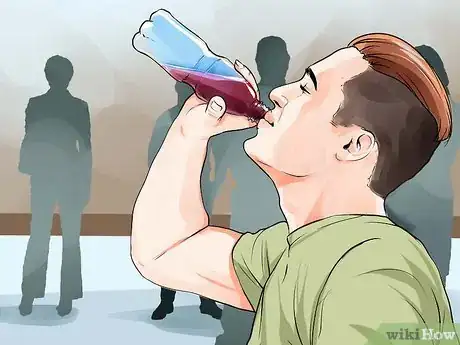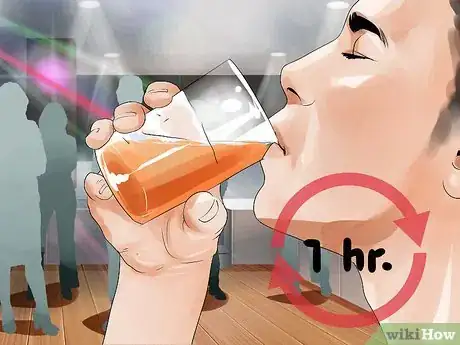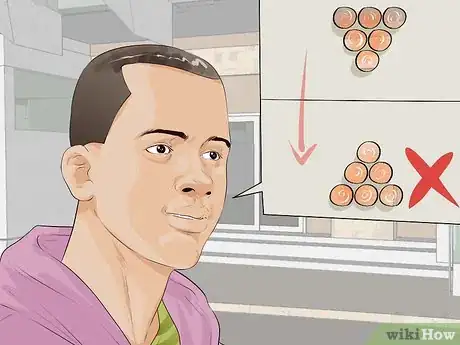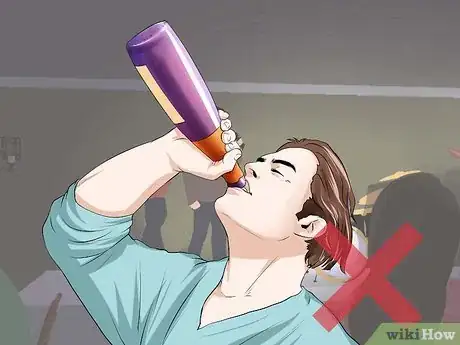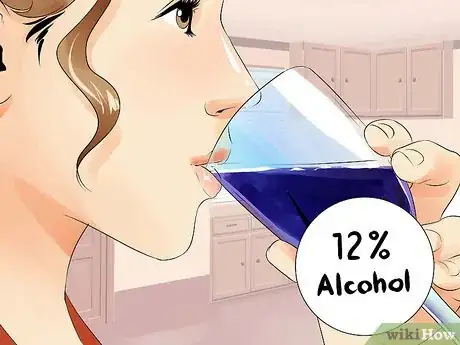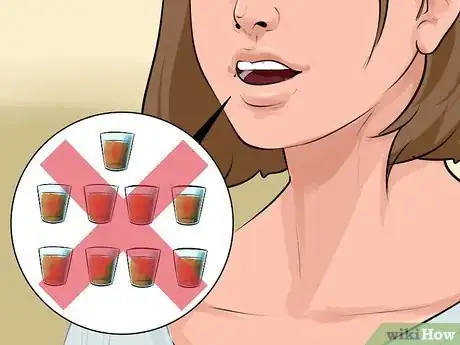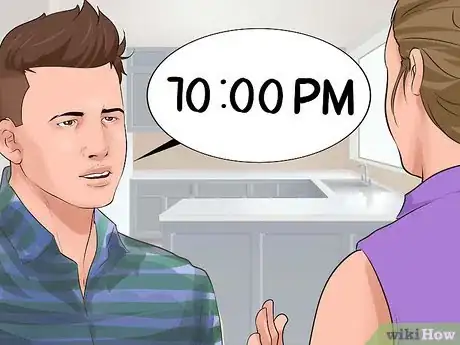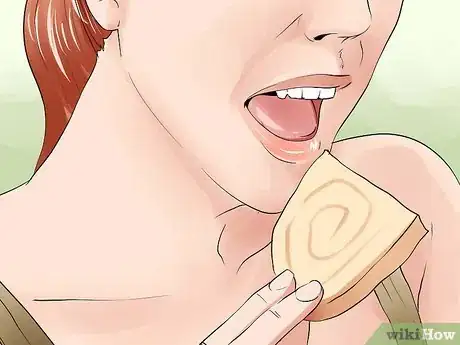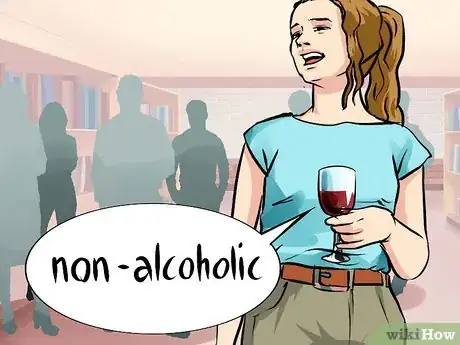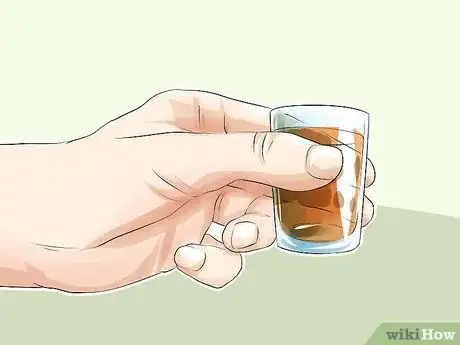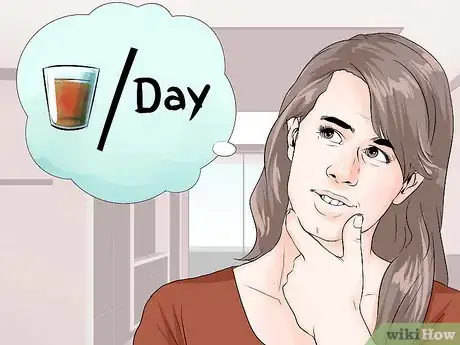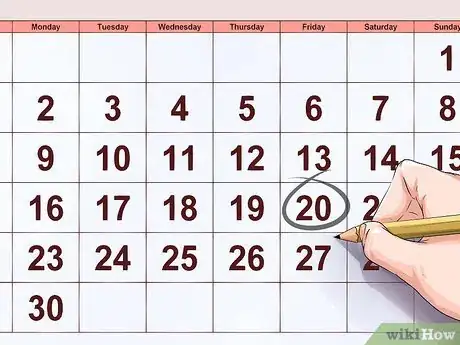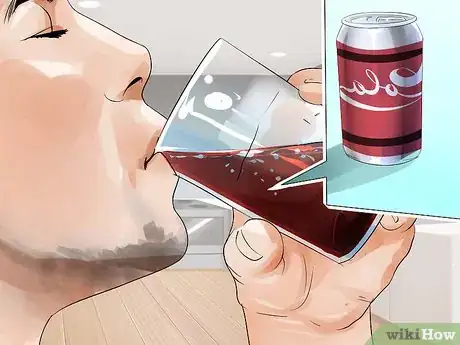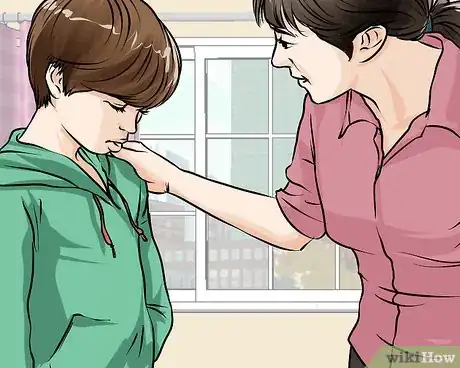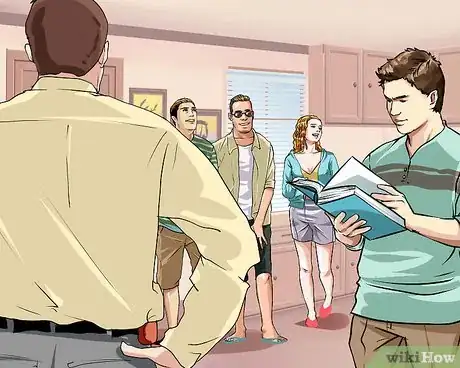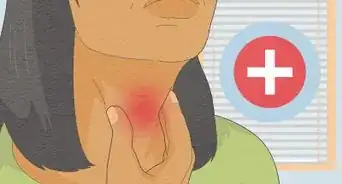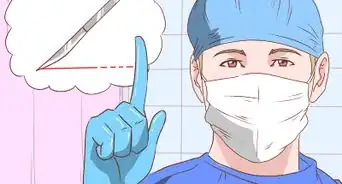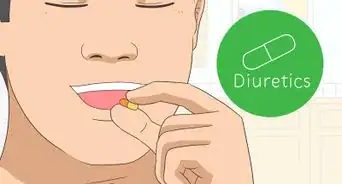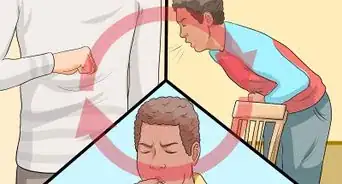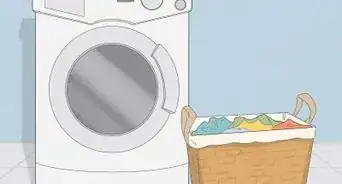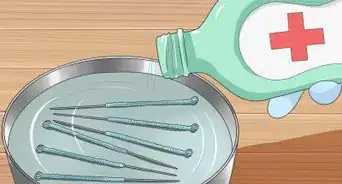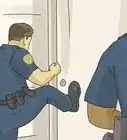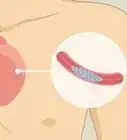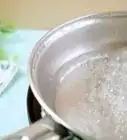This article was co-authored by Tala Johartchi, PsyD. Dr. Tala Johartchi is a Clinical Psychologist based in the Los Angeles, California metro area. With expertise and advanced training in Evidence-Based Practices and therapeutic/behavioral frameworks, Dr. Johartchi specializes in working with individuals, couples, and families experiencing Substance Disorders, Love Addiction and Codependency, Post Traumatic Stress Disorder, as well as common co-occurring disorders such as Depression, Anxiety, and Relational/Attachment difficulties. She earned an MA and PsyD in Clinical Psychology from The American School of Professional Psychology at Argosy University, San Francisco.
There are 12 references cited in this article, which can be found at the bottom of the page.
This article has been viewed 66,617 times.
Alcohol poisoning occurs when a high level of alcohol is present in your bloodstream and is caused by excessive alcohol consumption. Alcohol poisoning is typically accompanied by drunkenness, and often results in vomiting, semi-consciousness and possibly unconsciousness.[1] In extreme cases, it also can lead to death, and in fact, six people on average die from alcohol poisoning every day in the United States.[2] While alcohol poisoning can be fatal, it can be prevented by learning to drink in moderation and by supervising your kids' activities in your home.
Steps
Drinking Less Alcohol While Partying
-
1Make some drinks non-alcoholic. When you're out drinking, don't make every drink an alcoholic drink. Try drinking a soft drink or water instead of alcohol for some of your drinks to cut down on your alcohol intake — try making every other drink a non-alcoholic one.[3]
-
2Drink one alcoholic drink per hour. To play it safe, consider only drinking a single alcoholic drink per hour. That means one glass of wine, one 12-ounce beer, or one 80-proof shot.[4]
- Also, try not to switch back and forth on what you're drinking. If you're drinking beer, stick with beer; if you're drinking hard liquor, stick with that. Switching can sometimes lead to over-drinking.[5]
Advertisement -
3Skip drinking games. Drinking games encourage you to drink alcohol quickly in a short period of time. This type of behavior can easily lead to alcohol poisoning, so try to bow out of drinking games.[6]
- If you really want to participate, substitute a non-alcoholic beverage like soda or juice.
-
4Resist chugging. Another dangerous habit is chugging alcohol. It can be tempting to chug when people around you are encouraging you to drink faster; however, drinking too fast can lead to alcohol poisoning, as you're putting a lot of alcohol in your system in a short period of time.[7]
- Any alcohol you liver cannot process floats around in your bloodstream and finds its way to the brain, where it damages cells and, in high enough quantities, can shut down the brain stem. Chugging is like mainline alcohol into your brain.
-
5Pick lower-strength drinks. Not all drinks are created equal when it comes to alcohol content. Therefore, it can help to pick drinks that aren't as strong, to help lower how much alcohol you consume.[8]
- For instance, a 5-ounce glass of wine at 12 percent alcohol is considered one drink, while a 12-ounce glass of beer at 5 percent is also considered one drink. However, some lagers can have a much higher alcohol content. In addition, 1.5 ounces (one shot) of 80 proof alcohol is considered one drink. So if you're drinking something that has multiple shots in it, you're drinking more than one drink at once.[9]
-
6Understand your limits. For a 160-pound guy, 15 shots in three or four hours could lead to alcohol poisoning. For a 120-pound woman, it may only take nine shots in the same amount of time. Finding your limit is not an exact science. Many factors determine how much alcohol it would take to give you, personally, alcohol poisoning, so it's better to play it safe.[10]
- For instance, how fast you drink affects your alcohol level.[11]
- The weather, too, can affect your limit. The water content of your body helps to mitigate the alcohol in your bloodstream. So if you've been working out or sweating recently, or it's very hot out, your threshold for alcohol may actually be lower.
- In addition, how healthy you are can affect how much alcohol you can drink, as can how much you normally drink. In other words, if you don't normally drink, alcohol can affect you more.[12]
- Consider that some drinks have as many as five shots in them, so drinking that much is easier than it sounds.
-
7Stick to a plan. For instance, tell yourself you're only going to have three drinks. When you're done with those drinks, stop drinking. You can also pick a time to stop drinking, such as you'll stop drinking at 10:00 PM. Having someone with you who is committed to the same plan can help.[13]
-
8Have a designated sober person. It's always a good idea to have a designated driver who's not drinking; however, you can also ask that person to keep an eye on how much alcohol you're drinking to help you stop if you need to.[14]
-
9Eat before you drink. Having food in your stomach slows down how much alcohol your body can absorb. Nonetheless, you can still get alcohol poisoning even if you have eaten, so don't think it's a free pass to drink as much as you want.[15]
-
10Resist peer pressure. It's not always easy to say "no" when your friends are encouraging you to drink. In fact, it can be downright difficult because you naturally want to fit in and please your friends. However, it's important to stand up for yourself, especially if the consequences could mean alcohol poisoning for you.[16]
- One way to get out of drinking is to offer to be the designated driver. That way, you have a solid reason to say "No."[17]
- Have an excuse. You could say that you have an early morning or a test the next day. You could also say that you're on a sports team, and you need to be at your peak performance the next day. As an example, you could say, "I'd like to drink, but coach really doesn't like it. I need to be at my best all the time, or I'll get kicked off the team."[18]
- Be sneaky. You don't have to advertise that you're not drinking. If you've got a drink in your hand, even if it's non-alcoholic, people will likely think you're drinking, so just play along.[19]
- Of course, you can always just say "No." You have a right to say what happens with your body.[20]
- Escape to the dance floor. If you're busy dancing or even singing karaoke, people are less likely to try to press a drink in your hand.[21]
- Substitute an alcoholic beverage with a mocktail, so you can socialize and still be a part of the group without worrying about your consumption.
Limiting Your Daily Intake
-
1Keep smaller glasses on hand. The smaller the glass, the less you pour. Therefore, having smaller glasses can help curb your alcohol consumption.[22]
-
2Stick to a drink or so a day. Try to drink in moderation. For women, that means one drink a day. For men, that means two drinks a day until age 65, then you should switch to a single drink a day.[23]
-
3Find different ways to relax. Some people use alcohol to slow down after a day's work. Instead, try finding other ways to wash away the day. For instance, consider doing some exercise, like taking a walk around the park. Another alternative is meditation or deep breathing techniques.[24] Yet another option is spending time with your family and friends or going and doing something you enjoy.[25]
-
4Skip a day. Give yourself at least one alcohol-free day a week. Even skipping one day can help you lower your overall intake. Once you skip a single day a week, try moving towards two days a week.[26]
- This also gives your body the time it needs to repair any damage caused by the alcohol.
-
5Don't keep as much alcohol on hand. For instance, if you only have one bottle of your favorite alcohol on hand, when it's finished, it takes much more of an effort to go to the store and buy another bottle than if you were to just grab your back-up bottle from the pantry. This can help limit how much you consume.[27] Similarly, try buying other non-alcoholic drinks that you like and have them on hand instead.[28]
Keeping Kids Safe
-
1Lock up the alcohol. To keep your kids from getting into your alcohol, lock it up in a safe place so they cannot get to it. If you don't, smaller kids may drink it unknowingly, and teens may seek it out. Make sure to include all your alcohol, not just the hard stuff.[29]
-
2Put alcoholic household items where your kids can't reach them. Products that contain alcohol, such as mouthwash and cosmetics, can still give kids alcohol poisoning, as well as being potentially harmful otherwise. Make sure to keep these products where your kids can't get to them.[30]
-
3Have a conversation with your teens. Teens need to know how dangerous drinking can be, and they need to hear it from you. Let them know that binge drinking is especially dangerous and that it can even be fatal.[31]
- Make sure they know dangers of alcohol poisoning, as well as the signs. Also, lay out what can lead to alcohol poisoning and how they can keep themselves from getting it. Tell them what to do in a situation if they find one of their friends passed out — call for an ambulance. #*Some teenagers may be afraid to call an ambulance or get their friend help because they are afraid of getting in trouble with their parents or for underage drinking. Make sure your kids understand that their friend's life may be at stake, and that the consequences of not getting help far outweigh the potential punishment for drinking.[32]
-
4Supervise your teens' parties. If your teens have friends over, make sure to be around enough to make sure they aren't drinking.[33] Besides the obvious fact that it's dangerous to all involved, you can also be held responsible for anything that happens to the teens, if you know what's going on and don't stop it.[34]
References
- ↑ http://www.nhs.uk/Conditions/alcohol-poisoning/Pages/Prevention.aspx
- ↑ http://www.cdc.gov/vitalsigns/alcohol-poisoning-deaths/
- ↑ http://www.nhs.uk/Conditions/alcohol-poisoning/Pages/Prevention.aspx
- ↑ http://parentactionondrugs.org/wp-content/uploads/2013/07/PAD-Teens-Partying-and-Alcohol-Poisoning-20132.pdf
- ↑ http://www.nhs.uk/Conditions/alcohol-poisoning/Pages/Prevention.aspx
- ↑ http://depts.washington.edu/livewell/alcohol-drug-education/alcohol-poisoning/
- ↑ http://depts.washington.edu/livewell/alcohol-drug-education/alcohol-poisoning/
- ↑ http://www.nhs.uk/Conditions/alcohol-poisoning/Pages/Prevention.aspx
- ↑ http://rethinkingdrinking.niaaa.nih.gov/How-much-is-too-much/What-counts-as-a-drink/Whats-A-Standard-Drink.aspx
- ↑ http://depts.washington.edu/livewell/alcohol-drug-education/alcohol-poisoning/
- ↑ http://depts.washington.edu/livewell/alcohol-drug-education/alcohol-poisoning/
- ↑ https://www.mayoclinic.org/diseases-conditions/alcohol-poisoning/symptoms-causes/syc-20354386
- ↑ http://parentactionondrugs.org/wp-content/uploads/2013/07/PAD-Teens-Partying-and-Alcohol-Poisoning-20132.pdf
- ↑ http://parentactionondrugs.org/wp-content/uploads/2013/07/PAD-Teens-Partying-and-Alcohol-Poisoning-20132.pdf
- ↑ https://www.mayoclinic.org/diseases-conditions/alcohol-poisoning/symptoms-causes/syc-20354386
- ↑ https://teens.drugabuse.gov/blog/post/6-tactful-tips-resisting-peer-pressure-to-use-drugs-and-alcohol
- ↑ https://teens.drugabuse.gov/blog/post/6-tactful-tips-resisting-peer-pressure-to-use-drugs-and-alcohol
- ↑ https://teens.drugabuse.gov/blog/post/6-tactful-tips-resisting-peer-pressure-to-use-drugs-and-alcohol
- ↑ https://teens.drugabuse.gov/blog/post/6-tactful-tips-resisting-peer-pressure-to-use-drugs-and-alcohol
- ↑ https://teens.drugabuse.gov/blog/post/6-tactful-tips-resisting-peer-pressure-to-use-drugs-and-alcohol
- ↑ https://teens.drugabuse.gov/blog/post/6-tactful-tips-resisting-peer-pressure-to-use-drugs-and-alcohol
- ↑ http://www.nhs.uk/Conditions/alcohol-poisoning/Pages/Prevention.aspx
- ↑ https://www.mayoclinic.org/diseases-conditions/alcohol-poisoning/symptoms-causes/syc-20354386
- ↑ http://www.nhs.uk/Conditions/alcohol-poisoning/Pages/Prevention.aspx
- ↑ https://healthfinder.gov/HealthTopics/Category/health-conditions-and-diseases/heart-health/drink-alcohol-only-in-moderation
- ↑ https://healthfinder.gov/HealthTopics/Category/health-conditions-and-diseases/heart-health/drink-alcohol-only-in-moderation
- ↑ https://healthfinder.gov/HealthTopics/Category/health-conditions-and-diseases/heart-health/drink-alcohol-only-in-moderation
- ↑ http://www.nhs.uk/Conditions/alcohol-poisoning/Pages/Prevention.aspx
- ↑ https://my.clevelandclinic.org/childrens-hospital/health-info/ages-stages/adolescence/hic-What-Parents-of-Teenagers-Should-Know-About-Alcohol
- ↑ https://www.mayoclinic.org/diseases-conditions/alcohol-poisoning/symptoms-causes/syc-20354386
- ↑ https://www.mayoclinic.org/diseases-conditions/alcohol-poisoning/symptoms-causes/syc-20354386
- ↑ https://www.mayoclinic.org/diseases-conditions/alcohol-poisoning/symptoms-causes/syc-20354386
- ↑ https://my.clevelandclinic.org/childrens-hospital/health-info/ages-stages/adolescence/hic-What-Parents-of-Teenagers-Should-Know-About-Alcohol
- ↑ http://parentactionondrugs.org/wp-content/uploads/2013/07/PAD-Teens-Partying-and-Alcohol-Poisoning-20132.pdf
